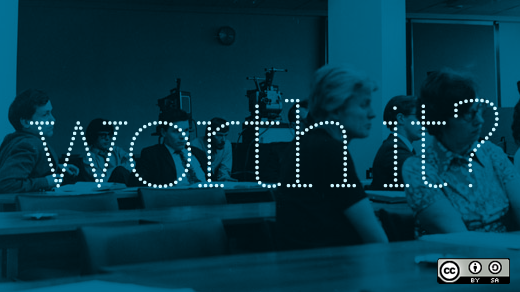In 2016, I wrote an article on running the perfect 30-minute meeting. And since then, I've continued to spread the word about the benefits of shorter meetings—and continued to run (most of) my meetings in 30 minutes or less.
Over the past two years, the conversation surrounding an open approach to meetings has intensified. Let me share the feedback, comments, and additional ideas I've received from others in that time.
Respect the time, respect the people
Everyone is busy. And in open organizations especially, people may need to meet frequently. One way to show your respect for others is by respecting their time. That means being on time to meetings and ending meetings on time, too, as participants might have additional commitments after the present one.
You might consider building a system of accountability around this principle. For example, at a former workplace, our team experimented with a penalty for being late. If the total waste of the meeting's time exceeded a specified amount, offenders had to bring cake to the next meeting. Let's say the meeting involved eight people and the limit for wasted time was 20 minutes. If the other seven attendees were on time and you were five minutes late, the total time you wasted in this situations was equal to five minutes times seven people—a total of 35 wasted minutes. So you had to bring cake to the next meeting.
Another example of this practice comes from the Kanbanize blog, which explains how you might charged a $1 penalty for being late—which then could be used for charity or as a donation to company events.
However, I'm not a fan of penalties; I believe you should respect your coworkers' and company time regardless of negative consequences. To me, inducing penalties demonstrates a lack of trust, and by doing so you also introduce the risk of people starting to game the system. Say you're running late to a meeting. Is it then more tempting to skip the meeting altogether than to show up late?
Summaries and action points
Have you ever left a meeting thinking you were all on the same page—but then, in a later discussion, realized others had a wholly different interpretation of what was said or decided?
At the conclusion of the meeting, quickly summarize the meeting to make sure everyone participating has the same view (just be careful not to fall into an endless spiral of repetition, though!). If action points emerged as a result of the meeting, then make sure to review those too.
Make only one person responsible for each action point. Shared responsibility is often no responsibility. This doesn't mean that the person assigned to an action point must do everything required to complete it; it only means that this person is solely responsible for ensuring completion of the action point (making sure the task gets done and presenting status and results later on). Some argue all action points should have an end date, but I'm not so keen on setting arbitrary deadlines unless there really is a fixed deadline of some kind. We should learn to finish things without having imaginary deadlines.
After the meeting, take time to write a summary of the discussion (or, at the very least, all decisions the group made). Send the summary to all invited—including those who might not have made it to the meeting—and other stakeholders.
Why?
Let me explain.
All meetings are optional
Complete transparency about meeting proceedings or outcomes is critically important, especially if your team has decided that all meetings are optional.
One of the first comments on my previous article came from Jeff Mackanic who was experimenting with making all his team's meetings optional. That approach is growing in popularity—or at least I've noticed it more now than I have in the past.
In short, an "optional meetings" policy means no one is obligated to attend any meeting and is instead free to pass the invitation on to others you think would add value to the meeting. It goes hand-in-hand with a practice some call "The Law of Two Feet": If you attend a meeting and you're neither learning or contributing, then you walk away.
Succeeding with this practice involves sending out an agenda before a meeting (so people can determine whether they really need to attend) and circulating notes after the meeting (so people can learn what they might have missed). Your team also needs to decide the extent to which it will allow people not in attendance at a meeting to have any input into decisions you made there.
Jurgen Appelo sparked a good discussion on Twitter when he tweeted about optional meetings. For Appelo, whether an option meeting policy proves effective boils down to culture and attitude towards meetings, as well as to adequate meeting planning and communication about the topics to be discussed at the meeting. If that communication is poor, people might not show up. And if the communication in the meeting is poor, people might leave.
Still, I struggle to understand how you'd know in advance whether or not you'd add value in a meeting. What if you decide not to go and the meeting organizer has an idea on which she or he would have liked to have your unique input? There's also the other side of the coin (which Sam Knuth has explained previously) where you find yourself not invited to a meeting you think you should have been at. Perhaps a collaborative culture and great communication before the meeting could solve that, too.
In any case, you should always send out an agenda beforehand, so people can prepare and also evaluate if they should or need to attend the meeting. Then, as I mentioned earlier, send out a summary of the meeting and highlight any decisions the group made, to make possible additional feedback and to spread the knowledge of what everyone decided.
The best meeting is no meeting
One step further is a growing movement united under the hashtag #NoMeetings. In general, supporters like to skip any meetings whatsoever and just walk over to the person/s with whom you need and have a spontaneous conversation, either right there at the desk or in a room, and quickly go through the questions or issues. That way, the argument goes, you and/or the task you're working on will not be stuck waiting for someone else longer than you have to.
But what this approach misses is the cost of the interruptions involved for each person you talk to. It also ignores the fact that you'll likely spend more time yourself repeating the same information several times to different stakeholders. And just because right now is a convenient time for you, the person you are going to talk to might be busy or deeply focused on a task—which you are now interrupting.
How do you know that your task is more important than what the other person is working on at this very moment?
This approach, however, focuses necessary attention on purpose of the meeting. Do you really need a meeting, or could you handle this work by communicating in another way? Will it be a meeting full of one-way communication? If so, perhaps the information could be distributed through email or posted on the intranet instead. Many all-staff meetings are held to make sure everyone receive the same message or information at the same time. But not everyone is always able to attend such meetings due to a variety of potential reasons. Many meeting tools offer the possibility to record the meeting, but in my experience this feature is seldom used. In that way people who were ill, on vacation, or absent for any other reason that day (see above!) would still be able to receive the same information as the people who attended the meeting.
Despite the #NoMeetings movement, I still prefer to hold scheduled meetings, so I can plan my work around them if necessary. If I know I will be interrupted at 10:00 for a meeting, I won't start something major at 9:50. But I might be able to handle these emails before I have to go ...
Open to meeting
Meetings have their place in any organization—even an open organization. A good meeting can have great impact and ignite a sense of purpose.
Most organizations can still improve their culture around meetings, however. Cutting down on the number and length of meetings might save time, but abolishing them completely might hurt the business more than it benefits. Being more transparent inside and outside of meetings—and more collaborative in other or new ways—could make everyone feel more included and produce better results on a whole.
Trust your coworkers. Let themselves decide where they'll contribute and add the most value to collaborative activities. But also make sure to communicate clearly if you really want someone specific to attend a meeting—and be sure to explain why you feel that way. You'll notice that a person feeling trusted and autonomous will feel more empowered, and that will transfer to all their work and the results they are making.
Subscribe to our weekly newsletter to learn more about open organizations.






4 Comments